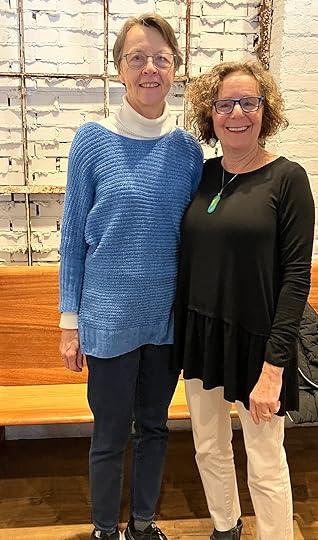My First Interview and My First 5-Star Goodreads Review!
I heard that writing a book was only part of the work an author does to get his or her book out into the world. Marketing and publicity are equally important! As I’m finding out, they’re equally time consuming.
What to Do Next?Each night I go to bed thinking about the jobs that for the next day. Should I respond to an interview request? Continue to send my Advanced Reader Copy (ARC) out to bloggers and readers who said they would review it? Or, maybe I should write an article for a regional or writing magazine. Should I work on bookmarks or update my business card? Create a ppt for my “Story Behind the Story” presentation? All of these are worthwhile. And all of them expand my own little circle of contacts to make my sphere of potential readers bigger–as I heard about on a recent episode of the Novel Marketing podcast. (Writer friends–I highly recommend this podcast!)
My First Interview!I started this week by answering questions from my joined-at-the-hip-writer-buddy, Linda Phillips. For those of you who have been following my blog for years (thank you!) you may remember when I shared Linda’s first verse novel CRAZY and her second one, BEHIND THESE HANDS. Linda is a strong advocate of mental health; her books and her volunteer work speak to that lifelong passon.
Well, now it’s my turn! Below is our interview that she posted in her newsletter for the Charlotte Clubhouse. It is used with her permission.
LINDA: I understand that birthing this book has been a long journey. What did you originally set out to write about and how, if at all, did that change along the way?
CAROL: I was curious about what it was like in Charlotte before civil rights and thought I would write about that. At my first Highlights workshop (that you and I attended together in 2009!) I was fortunate to have Harold Underdown as my mentor. When I told him I was writing a book about Charlotte before civil rights, he told me that was only my setting. He encouraged me to find out what my character wanted. I remember being blown away by that simple yet profound advice.
It took me years digging into Kate’s (my protagonist) past and finding her story to answer Harold’s question. Once I settled on what was driving Kate, I could shape the book. There were many outlines and drafts in the process. In addition, since the period is the Jim Crow South, I knew there were racial issues that would be addressed. Over time I realized that most of that racial struggle was not my story to tell. As a result, HALF-TRUTHS became more about Kate’s journey to find her voice as a budding journalist, rather than a book about racial relations.
LINDA: What message do you want readers to take away from your book?
CAROL: Don’t push family secrets under the rug. A person’s past influences their present. Whenever possible, open communication is best. That communication leads to healthier and more genuine relationships.
The theme of half-truths runs throughout the book. Kate not only uncovers deceptions that have been passed on in her family, but she also comes to grips with her half-truths. Lillian, an important secondary character, is a teenage Black maid who works for Kate’s grandmother. The two girls bond over taking care of Kate’s goat, and while building that friendship, Kate frequently stumbles. In a major turning point, Kate alienates Lillian by publicly saying a half-truth about Lilian. It is only when Kate admits what she did and communicates her genuine regret to Lillian that their friendship is reconciled.
As the story progresses, Kate discovers secrets about her family’s ancestry. She wants to talk about them to her stern grandmother— the lynchpin in the puzzle—but she’s afraid. At the end of the book, she broaches the topic as the two plant a garden together. Kate’s hunch about her family is validated and she breaks through walls that have existed for decades. She is then freer to speak her voice and move forward without crippling fear.
LINDA: DEI has come under attack in recent days, and President Trump is eliminating many programs that will have possible negative impacts on persons of color. Your protagonist, Kate, was outspoken and strong-willed. How do you think she might react if she were around to see this today?
CAROL: I think she would want everyone to be treated equally. Like she says in HALF-TRUTHS, “Of course, all men are created equal! That’s what is written in the Bible and the Declaration of Independence!” She’d be glad to see the progress since 1950: she didn’t experience integrated schools, parks, restaurants, sports teams, or businesses. She would want this to continue—that the same opportunities would be available to both Blacks and Whites.
LINDA: Lastly, you know I write about mental illness. Is there any part of Half-Truths that resonates with mental health issues?
CAROL: Definitely! Families that deny or bury secrets often pass along burdens to subsequent generations. These “half-truths” lead to shame, guilt, fear, and resentment. In turn, carrying around those burdens can result in miscommunication, failed relationships, poor decision- making, anxiety, depression, or worse.
 My First 5-Star Goodreads Review!
My First 5-Star Goodreads Review!As it turns out, Linda was the first person to review Half-Truths on Goodreads. (While you’re on that page, please mark Half-Truths as “want to read.”) It’s been exciting to hear what others think about my first novel. Here are Linda’s thoughts:
Kate Dinsmore, the teenage protagonist in this book you won’t want to put down, and the author, Carol Baldwin, have a lot in common. They both have a way with words and aim to use them to make the world a better place to live. In her first fiction YA novel, Baldwin has used her keen research instincts to give us an historically accurate and compelling picture of racial tensions in both rural and urban settings in 1950s North Carolina. Against a backdrop of KKK rallies and racial prejudice, Kate dreams of going to college and becoming a reporter. When it looks like her tobacco-farming family will likely not be able to afford it, her wealthy Charlotte grandparents agree to let her live with them to attend school. Kate knew living with her aloof and society-minded grandmother would be challenging, but she had no idea how the young, hired help in the household would change her life forever. Kate’s curiosity and observations soon lead to questions about her family tree. There are material items and story fragments in the house and among family members that don’t add up. Baldwin effectively uses the fragile relationship between Kate and her newfound cousin, Lillian, to illustrate the importance of truth-telling, especially across racial lines. I highly recommend this book to teachers and students for its accurate depiction of pre-Civil Rights and the Jim Crow era.
FriendsIt’s no wonder I wrote about friendship in my debut novel. I’ve been blessed with so many wonderful friends who supported and prayed for me on this 18-year journey.
Friends just like Linda.

Image from Pixabay courtesy un-perfekt.
The post My First Interview and My First 5-Star Goodreads Review! first appeared on Carol Baldwin - Author, Teacher, Speaker .



